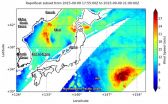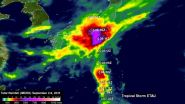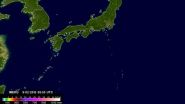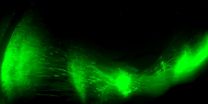NASA looks at Japan's torrential rains and winds from twin tropical cyclones
2015-09-10
(Press-News.org) Japan has experienced large rainfall that caused flooding and large evacuations as a result of two weather systems. NASA's GPM Core satellite measured rainfall as NASA's RapidScat saw Etau and Typhoon Kilo on either side of Japan.
Over the past week Japan has experienced extreme rainfall that resulted in flooding, landslides and many injuries. A nearly stationary front that was already moving over Japan caused much of the rain but Tropical Storm Etau also interacted with the front and magnified the scale of the deluge.
Heavy rainfall led to the evacuation of over one million people. The area around the city of Joso, located in the Ibaraki prefecture and north of Tokyo, received as much as 600 mm (24 inches) of rainfall. The Aichi prefecture where Joso is located received rainfall and winds near 78 mph (125 kph). According to the Japan Meteorological Agency, the hardest-hit areas were the Ibaraki and Tochigi prefectures
The Global Precipitation Measurement (GPM) core satellite provided rainfall data on the weather system. This rainfall analysis from space was generated at NASA's Goddard Space Flight Center in Greenbelt, Maryland, using NASA's Integrated Multi-satellite Retrievals for GPM (IMERG) data. It shows rainfall total estimates for Japan during the seven day period from September 2 to 9, 2015 when Japan was getting drenched.
This analysis indicates that much of Japan's main island of Honshu had over 100 mm (almost 4 inches) of rainfall. Extraordinary totals of over 750 mm (29.5 inches) were analyzed near the south-central coast of Honshu near where tropical storm Etau passed over the island.
After landfall in Japan, Tropical Storm Etau moved northward into the Sea of Japan. "RapidScat saw Etau on Sept 9 at 3:20 a.m. UTC (Sept. 8 at 11:20 p.m. EDT), still entangled with Japan and again near 4 p.m. EDT (20oo UTC) with a well-formed spiral," said Doug Tyler of NASA's RapidScat team at NASA's Jet Propulsion Laboratory in Pasadena, California. The evening picture shows Japan bracketed by Kilo to the east, and Etau to the west, in the Sea of Japan.
On September 10, satellite imagery showed Etau's remnants over the Primorsky Krai territory of southeastern Russia on the Sea of Japan. Meanwhile, Typhoon Kilo continued moving northward in the Northwestern Pacific Ocean.
INFORMATION:
ELSE PRESS RELEASES FROM THIS DATE:
2015-09-10
NEW YORK, NY (September 10, 2015)--Researchers have discovered why long-term use of L-DOPA (levodopa), the most effective treatment for Parkinson's disease, commonly leads to a movement problem called dyskinesia, a side effect that can be as debilitating as Parkinson's disease itself.
Using a new method for manipulating neurons in a mouse model of Parkinson's, a Columbia University Medical Center (CUMC) research team found that dyskinesia arises when striatonigral neurons become less responsive to GABA, an inhibitory neurotransmitter. This suggests that it may be possible ...
2015-09-10
Alexandria, VA - The American Geosciences Institute's (AGI) is pleased to announce the release of a community consensus statement on access and inclusion of geoscientists with disabilities. This statement was inspired by the 2014 AGI Leadership Forum, which brought together the Executive Directors and Presidents of AGI's Member Societies to discuss the issue of access and inclusion of persons with disabilities in the geosciences.
The meeting was facilitated by the Executive Director of the International Association for Geoscience Diversity (IAGD) Christopher Atchison, ...
2015-09-10
NASA's RapidScat instrument analyzed the sustained surface winds of Tropical Storm Henri on Sept. 8 as the storm was intensifying.
When the International Space Station flew over Tropical Depression 8 in the Eastern Atlantic Ocean on September 8 at 1p.m. EDT, NASA's RapidScat instrument aboard captured data on the storm's surface winds. RapidScat showed that there were tropical-storm-force winds north and east of the center near 27 meters per second (60.4 mph/97.2 kph). However, sustained winds on the west and southwestern quadrants were near 12 meters per second (26.8 ...
2015-09-10
September 10, 2015 (Washington) - There are substantial differences among Americans when it comes to knowledge and understanding of science topics, especially by educational levels as well as by gender, age, race and ethnicity, according to a new Pew Research Center report.
The representative survey of more than 3,200 U.S. adults finds that, on the 12 multiple-choice questions asked, Americans gave more correct than incorrect answers. The median was eight correct answers out of 12 (mean 7.9). Some 27% answered eight or nine questions correctly, while another 26% answered ...
2015-09-10
DOWNERS GROVE, Ill.-- September 10, 2015--Having patients lie on their left side while the right side of their colon is being examined can result in more polyps being found, thus increasing the effectiveness of colonoscopy for colorectal cancer (CRC) screening, according to a study in the September issue of GIE: Gastrointestinal Endoscopy, the monthly peer-reviewed scientific journal of the American Society for Gastrointestinal Endoscopy (ASGE).
CRC is one of the most common cancers in the US and other western countries. Studies have shown that deaths from CRC are reduced ...
2015-09-10
Two recently published studies in the journals Age and the British Journal of Nutrition (BJN) demonstrate that consuming cocoa flavanols improves cardiovascular function and lessens the burden on the heart that comes with the ageing and stiffening of arteries. The studies also provide novel data to indicate that intake of cocoa flavanols reduces the risk of developing cardiovascular disease (CVD).
As we age, our blood vessels become less flexible and less able to expand to let blood flow and circulate normally, and the risk of hypertension also increases. Arterial stiffness ...
2015-09-10
This news release is available in German. Protein labeling with synthetic fluorescent probes is a key technology in chemical biology and biomedical research. The target proximity achieved by small-molecule probes is essential to exploit the full potential of super-resolution fluorescence microscopy. Single-molecule localization techniques provide high spatial resolution by reporting on the position of the fluorophore and thus only indirectly on the target molecule itself. Large labels, such as antibodies, can misleadingly position a fluorophore tens of nanometers away ...
2015-09-10
An international research team, which includes NYU anthropologists Scott Williams and Myra Laird, has discovered a new species of a human relative. Homo naledi, uncovered in a cave outside of Johannesburg, South Africa, sheds light on the diversity of our genus and possibly its origin.
"This discovery is unprecedented in the sheer number of hominins collected from such a small area in the virtual absence of other animal remains," says Williams, an assistant professor in NYU's Department of Anthropology. "That makes this site unique. Moreover, the announcement describes ...
2015-09-10
Bethesda, MD (Sept. 10, 2015) -- Detection of small fragments of tumor DNA, known as circulating tumor DNA, in a patient's pre-surgery serum samples predicts early recurrence of hepatocellular carcinoma and may guide treatment, according to a study1 published in Cellular and Molecular Gastroenterology and Hepatology, the basic and translational science journal of the American Gastroenterological Association. Hepatocellular carcinoma -- the most common type of liver cancer -- is the third leading cause of cancer deaths worldwide.
"We uncovered that circulating tumor DNA ...
2015-09-10
The steps involved in evaluating and diagnosing patients with epilepsy are complicated. In a new and extensive literature review of available information, experts provide insights on the valuable role of genetic testing in the diagnosis and care of pediatric epilepsy.
Epilepsy is a common neurological disorder that affects up to 1.5% of the world's population and is more commonly diagnosed in children than adults. Most cases of epilepsy have been considered "idiopathic" or of unknown cause, but recent advances in genetic testing are providing insights on the potential ...
LAST 30 PRESS RELEASES:
[Press-News.org] NASA looks at Japan's torrential rains and winds from twin tropical cyclones





